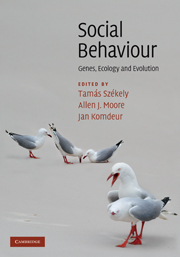Book contents
- Frontmatter
- Contents
- List of contributors
- Introduction: The uphill climb of sociobiology: towards a new synthesis
- Profile: Undiminished passion
- Part I Foundations
- 1 Nature–nurture interactions
- Profile: Social evolution, sexual intrigue and serendipity
- 2 The quantitative genetics of social behaviour
- Profile: Mating systems: integrating sexual conflict and ecology
- 3 Social behaviour and bird song from a neural and endocrine perspective
- Profile: In love with Ropalidia marginata: 34 years, and still going strong
- 4 Evolutionary game theory
- Profile: The huddler's dilemma: a cold shoulder or a warm inner glow
- 5 Recent advances in comparative methods
- Profile: Multi-component signals in ant communication
- 6 Social evolution theory: a review of methods and approaches
- Profile: What's wrong with this picture?
- Part II Themes
- Part III Implications
- Species index
- Subject index
- References
2 - The quantitative genetics of social behaviour
Published online by Cambridge University Press: 05 June 2012
- Frontmatter
- Contents
- List of contributors
- Introduction: The uphill climb of sociobiology: towards a new synthesis
- Profile: Undiminished passion
- Part I Foundations
- 1 Nature–nurture interactions
- Profile: Social evolution, sexual intrigue and serendipity
- 2 The quantitative genetics of social behaviour
- Profile: Mating systems: integrating sexual conflict and ecology
- 3 Social behaviour and bird song from a neural and endocrine perspective
- Profile: In love with Ropalidia marginata: 34 years, and still going strong
- 4 Evolutionary game theory
- Profile: The huddler's dilemma: a cold shoulder or a warm inner glow
- 5 Recent advances in comparative methods
- Profile: Multi-component signals in ant communication
- 6 Social evolution theory: a review of methods and approaches
- Profile: What's wrong with this picture?
- Part II Themes
- Part III Implications
- Species index
- Subject index
- References
Summary
Overview
How and when social behaviour evolves has long been a focus of study within evolutionary biology, yielding the entire subfield of sociobiology and behavioural ecology. Although social behaviours may be explored in the same way as any other type of phenotype, the genetics underlying social behaviours differ from traits that do not vary depending on the social environment in which they are expressed. Social behaviour is best described as an interacting phenotype: a phenotype that depends at least in part on interactions with social partners for its expression. Models of indirect genetic effects provide a quantitative genetic framework for understanding the sources of variation underlying interacting phenotypes. They also suggest a genetic mechanism for inheriting traits that are expressed among rather than within individual animals, and identify selection arising from the interactions (termed social selection).
This chapter will first introduce the concepts of interacting phenotypes, indirect genetic effects, and social selection. We build a quantitative genetic model for interacting phenotypes and discuss how the evolution of such traits differs from non-interacting traits. We then explore the parameters of the model in more depth. We subsequently summarise existing empirical studies of indirect genetic effects, discuss the implications for the evolution of behavioural traits through social selection, and discuss transitions between quantitative genetic and molecular genetic approaches to studying behavioural evolution. Finally, we highlight potential future avenues of research.
- Type
- Chapter
- Information
- Social BehaviourGenes, Ecology and Evolution, pp. 29 - 54Publisher: Cambridge University PressPrint publication year: 2010
References
- 24
- Cited by



